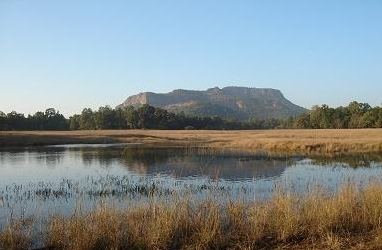Type Hill fort Controlled by Bahela Rajputs Condition Dilapidated Height 811 m | Open tothe public Yes Built 10th Century Phone 07627 265 314 | |
 | ||
Similar Bandhavgarh National Park, Chanderi fort, Hinglajgarh, Sabalgarh Fort, Kanha Tiger Reserve | ||
Bandhavgarh fort safari
The Bandhavgarh Fort is situated in Bandhavgarh in Umaria district of Madhya Pradesh, India. It is located on the Bandhavgarh hill, rising 811 meters above sea level at the centre of the Bandhavgarh National Park. It is a surrounded by a large number of smaller hills separated by gently sloping valleys. These valleys end in small, swampy meadows, locally known as 'bohera'. The fort is also home to many of the endangered species of Vulture in India
Contents
Origin
No records are available to show when Bandhavgarh fort was constructed. It is thought, however, to be some 2000 years old, and there are references to it in the ancient books, the "Narad-Panch Ratra" and the "Shiva Purana". Regional folklore suggests that Bandhavgarh Fort was constructed by rulers of the Gond Empire. Gond kings of the Pandro caste are the original builders of this fort, and descendants of Gond kings still live near the fort. Gond kings constructed 12 talab ponds, of which only few remain. This fort's construction and architecture are similar to other forts built by Gond Kings.
The Vanganga stream originates from Bandhavgarh Fort's hill. In Gondi language, van means surname and ganga loosely translates to a pure stream. That may suggest that Pandro, the surname of Gond kings, may have originated from "Vanganga" . The Bandhavgarh fort derives its name from the most prominent hillock of the area, which is said to be given by Lord Rama to his brother Lakshmana to keep watch on Lanka. Hence the name Bandhavgarh (bandhav as brother, garh as fort).
Bandhavgarh Fort was the business centre for the traders traveling between Kaushambi and Bharhut, at that time known as Bardawati (Bhaudhya root). During the Kalachuri dynasty it was called “Haihay Kshetra”. The Vakataka dynasty used this place, and various stone writings are found written by them. They made the place livable by cutting stones. There are some ruins found of the Fort in the Bamania Hill near Bandhavgarh, and there are many sculptures and coins found in the nearby villages near Bandhavgarh, Bijhariya, Mala which prove the economical and artistic situation of the kingdom. In the reign on Karan Deo (Vikram Samvat 1245-1260), Bandhavgarh was the capital of the southern part of the Gahora kingdom.
There are a few statues depicting the reincarnations of Vishnu (avatar) - like one of the Fish and another of the Turtle. There are some remaining ponds on the hill e.g. Rani Talab(Queen's Pond). There is a viewpoint on the hill called Suicide point, from which if one is lucky one can see the vultures in flight.
One the way back from the fort one can see a gigantic idol of Vishnu lying down, it is also known as Sesh Shai. The word Bandhavgarh means the Fort of Laxman, and the stone carved Shesh Shai also provides further evidence for the origin of this name.
History
Various dynasties have ruled the fort: for example, Mauryans from the 3rd century BC, Vakataka rulers from the 3rd-5th century, Sengars from the 5th century, and the Kalachuris from 10th century. In the 13th century, the Baghels took over, ruling from Bandhavgarh until 1617, when Maharaja Vikramaditya Singh moved his capital to Rewa. The last inhabitants deserted the fort in 1935.
Throughout the tour of Bandhavgarh fort, wildlife such as tigers, cubs, and deer can be seen. In addition, many rare species of birds like Malabar pied hornbill, falcons, 4 species of vultures, and tortoises swimming can also be seen. At some point one can also see vulture nests from above. The hilltop is considered best for photography of flying birds due to the advantage of being positioned at the top. This makes the Bandhavgarh fort a worthwhile addition to a Bandhavgarh National Park wildlife tour.
As of approximately 2012, it is no longer possible to visit Bandhavgarh fort, as the M.P. Forest Department is no longer granting anyone permission to do so. Only the large Vishnu statue at the base of the fort can be visited at present.
